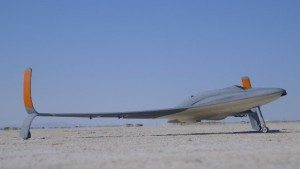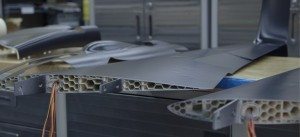Stratasys 3D Printing: Lightweight Stratasys Materials Help 3D Printed UAV Top 150 MPH
World’s First Jet-Powered, 3D Printed UAV Tops 150 MPH with Lightweight Stratasys Materials
Aurora Flight Sciences, a Virginia-based manufacturer specializing in advanced unmanned aerial vehicle (UAV) systems, is pushing the envelope of UAV design by teaming up with Stratasys to create the world’s first jet-powered, 3D printed aircraft.

Aurora’s UAV demonstrates Stratasys’ FDM-based 3D printing solutions ability to build a completely enclosed, hollow structure which, unlike other manufacturing methods, allows large – yet less dense – objects to be produced
Using 80% 3D printed parts, the UAV is composed of Stratasys’ ULTEM™ 9085 lightweight material to achieve flight speeds of over 150 mph. The high-speed system boasts an impressive 9-foot wingspan and weighs in at only 33 lbs. Dan Campbell, Aerospace Research Engineer at Aurora Flight Sciences, explains how the UAV project met a number of goals using Stratasys 3D printing solutions.
“A primary goal for us was to show the aerospace industry just how quickly you can go from designing and building to flying a 3D printed jet-powered aircraft. To the best of our knowledge, this is the largest, fastest, and most complex 3D printed UAV ever produced.”
Stratasys 3D printing solutions provided Aurora with unlimited design freedom and the capability to improve upon the design without the constraints of traditional manufacturing. Aurora was able to reduce time-to-market by cutting design and build time by 50% using Stratasys’ Fused Deposition Modeling (FDM) 3D printing technology.
Another advantage of employing Stratasys 3D printing was the ability to produce the structural components using high-performance ULTEM thermoplastic. ULTEM has become a popular choice for a variety of aerospace applications. Meeting FAA’s flame, smoke and toxicity (FST) requirements, it offers the greatest durability and highest heat and chemical resistance of any FDM thermoplastic. Additionally, ULTEM’s lightweight mechanical properties provide ideal conditions for aerospace operations.

Aurora’s UAV demonstrates Stratasys’ FDM-based 3D printing solutions ability to build a completely enclosed, hollow structure which, unlike other manufacturing methods, allows large – yet less dense – objects to be produced
“This is a perfect demonstration of the unique power that additive manufacturing can bring to aerospace,” says Scott Sevcik, Aerospace & Defense Senior Business Development Manager, Vertical Solutions at Stratasys. “This meant using different 3D printing materials and technologies together on one aircraft to maximize the benefits of additive manufacturing, and 3D print both lightweight and capable structural components.”
Stratasys and Aurora leveraged additional technologies provided by Stratasys Direct Manufacturing to fabricate other components, including a laser sintered nylon fuel tank and a 3D printed metal vectoring exhaust nozzle.
For Sevcik, this particular collaborative project with Aurora achieves one of the foremost overall goals among aerospace manufacturers, as well as those in other industries, which is the need to constantly reduce weight.
- Aurora’s UAV demonstrates FDM’s ability to build a completely closed, hollow structure which, unlike other manufacturing methods, allows large – yet less dense – objects to be produced
- SSYS Integrated Solutions Offering allowed Stratasys Direct Manufacturing (SDM) to produce the components that were better suited to other technologies
“Whether by air, water or on land, lightweight vehicles use less fuel. This enables companies to lower operational costs, as well as reduce environmental impact. In addition, using only the exact material needed for production is expected to reduce acquisition cost by eliminating waste and reducing scrap and recycling costs,” adds Sevcik.

 Blog
Blog